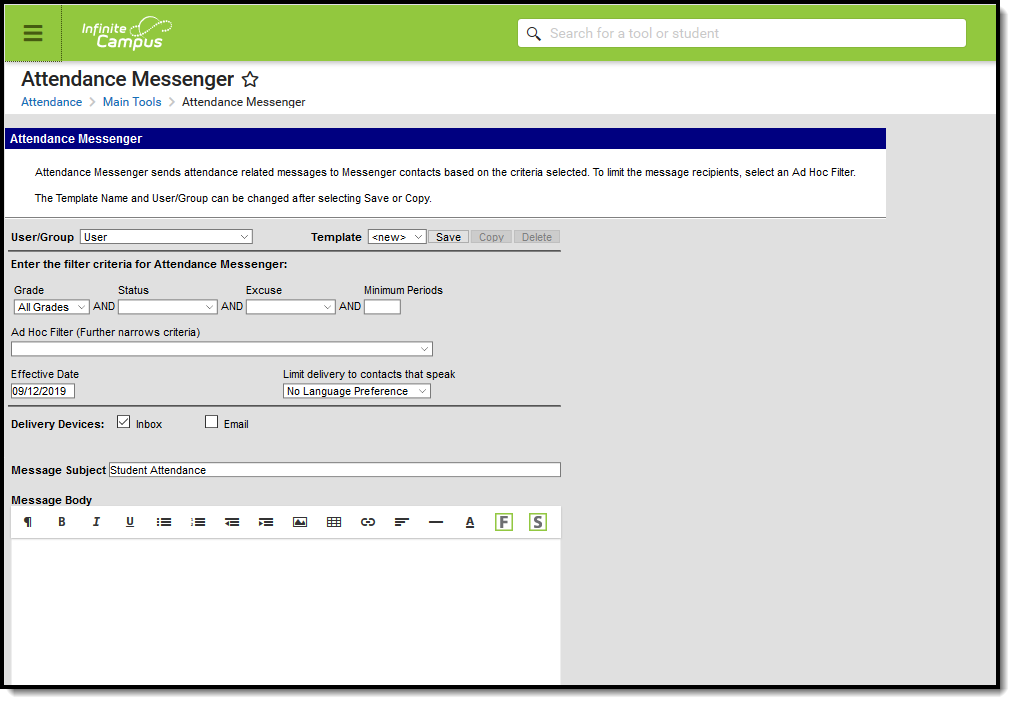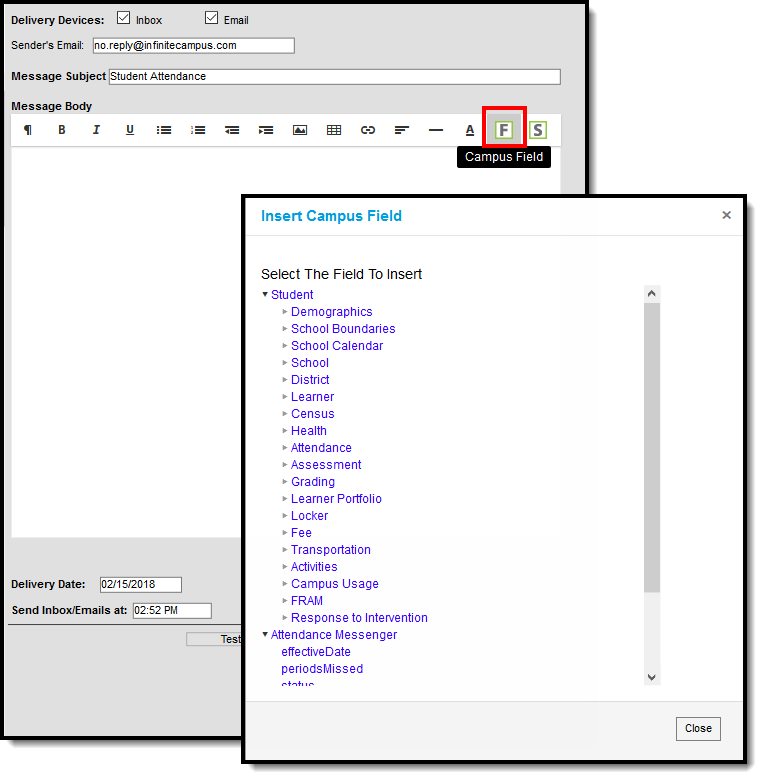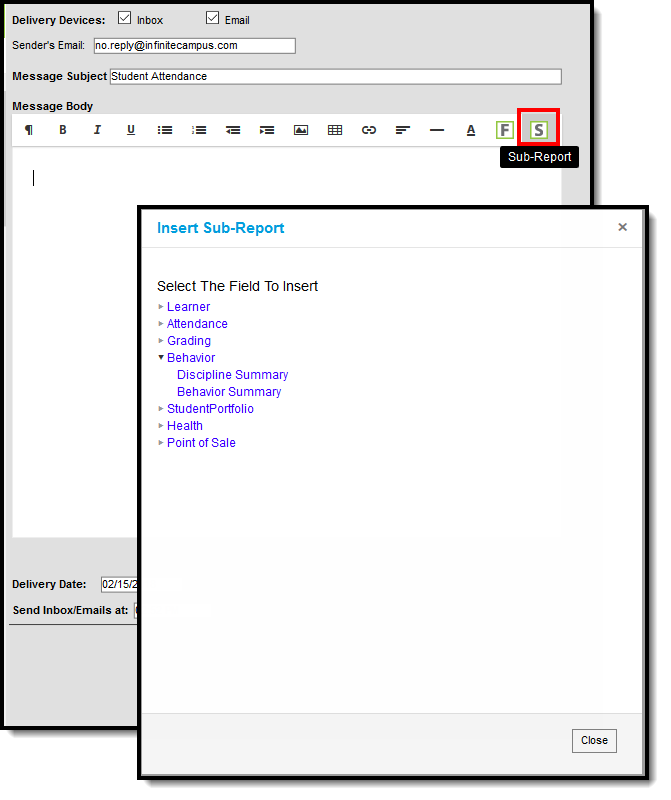Voice and text message features described in this article only apply to schools/districts that use Campus Messenger with Voice add-on functionality
The Attendance Messenger creates attendance message templates that specify delivery criteria. Messages may be sent to student messenger contacts immediately through this tool or set for automated delivery with the Attendance Messenger Scheduler tool.
This tool only works in the active school year.
Attendance Messenger Editor
See the Attendance Messenger Tool Rights article for information about rights needed to use this tool.
Attendance Messenger Field Descriptions
| Field | Description | ||||||
|---|---|---|---|---|---|---|---|
| User/Group | This dropdown list allows you to save message templates to your user account or a user group to which you belong. | ||||||
| Template | This dropdown list displays a list of available templates. To create a new template, select <new> from this list. | ||||||
| Filter Criteria | |||||||
| Grade | This field determines which grade(s) report in the message. | ||||||
| Status | This field determines which attendance records are include in the message, based on the assigned attendance status. One attendance status can be selected: Absent, Tardy or Early Release. | ||||||
| Excuse | This field determines which attendance records to include in the message, based on the assigned attendance excuse. One attendance excuse can be selected: Excused, Unexcused or Unknown. | ||||||
| Minimum Periods | This field determines which attendance records to include in the message. Enter the minimum number of periods for which the status and excuse combination must occur. Only Instructional periods are considered when sending attendance messages. Attendance recorded for non-instructional periods is NOT included. | ||||||
| Ad hoc Filter | This is a list of saved student-type Ad hoc filters. | ||||||
| Effective Date | The day on which the attendance event occurred. | ||||||
| Limit Delivery to contacts that speak | Use this field to limit message delivery to the language set in the Preferred Language Field on the person's Demographics tool. To send messages to student messenger contacts whose Preferred Language is English AND student messenger contacts whose Preferred Language is Spanish, two separate templates must be created. | ||||||
Delivery Devices | |||||||
| Inbox | The Inbox option is automatically selected. This option places a note in the student messenger contact's inbox that a new message is available. Infinite Campus strongly recommends leaving this option marked to ensure delivery to the student messenger contact with a Portal Account but no other delivery device marked for messages from teachers. | ||||||
| The Email option sends an email to the student messenger contact's email address on record (entered in Census > People > Demographics). | |||||||
| Voice | The Voice option calls the student messenger contact's phone number on record (entered in Census > People > Demographics). | ||||||
| Text | The Text option sends a text message to the student messenger contact's mobile device. Recipients who have indicated a desire to receive text messages must have the Text (SMS) checkbox marked in the Personal Contact Information editor of the Demographics tool to receive text messages. Sub-reports cannot be used for Text messages. | ||||||
| Message Details | |||||||
| Sender's Email | This field displays the email address that is automatically included in the message body for message recipients to reference. This field can be changed if the Allow Custom Sender's Email Address checkbox is marked on the Email Settings tool. Existing templates may display a different address if the Allow Custom Sender's Email Address checkbox is marked and a user modified the Sender’s Email field.
| ||||||
| Caller ID | This field displays the phone number that is automatically included in the message body for message recipients to reference.
This field can only be changed if the Allow Custom Caller ID checkbox is marked on the Voice Settings tool. Existing templates may display a different Caller ID if the Allow Custom Caller ID checkbox is marked and a user modified the Caller ID field. | ||||||
| Message Subject | This field determines the text that displays in the Subject field of the email message. The default subject is Student Attendance but can be changed to something else. | ||||||
| Message Body | This field contains the text contained in the message. See the Campus Insert Fields for Message Builder section for important information about inserting Campus fields in the Message Body and the Text Message body. The Message Body uses a WYSIWYG editor. For more information about using the options available with the editor, see the WYSIWYG Editors article. Do NOT copy attribute fields from another Messenger tool in Campus. The attribute fields are not the same. Message Body supports the use of Chinese characters for email messages only. | ||||||
This option allows you to send a voice message. See the article Messenger with Voice - Setup and Details for more information about this feature. You must click the Upload button after browsing for the attachment. When an attachment is properly uploaded, the Attach File message displays on the screen. | |||||||
| Browse and upload an email attachment | This option allows you to add an attachment to the email. See the article the Digital Repository Preferences or information about supported file types and sizes. You must click the Upload button after browsing for the attachment. When an attachment is properly uploaded, the Attach File message displays on the screen. | ||||||
| Text Message | The text message to be sent to the student messenger contact's mobile device. The ability to send text messages is controlled by a preference set by the District Administrator. There is a character limit of 400 characters for text messages. Infinite Campus recommends not exceeding 140 characters as this may result in multiple messages being sent to recipients in random order. The maximum length of a text message is set to 400 characters. When a text message reaches this length, a warning message displays indicating such. The message cannot be saved until the character limit is met.Existing text message templates still display in their entirety, but need to be modified to be within this limit before sending. If users wish to stop receiving text messages, they can text STOP to the short code. This results in the user receiving no further text messages from Campus, even if the user has the Text option marked on their Contact Preferences. Users need to go through the opt in process again to start receiving texts at a later date. | ||||||
| Delivery Date: | The day on which the message should be sent. | ||||||
| Send Inbox/Emails at: | The time inbox and/or email messages begin to be delivered. The time saves with the templates. If messages should always go out immediately after Send is selected, this field should be left blank. | ||||||
| Dial Window: | These fields create a dialing window during which a general voice message may be sent. The default values for these fields are set up on the Voice Settings tool. (System Administration > Messenger > Messenger Preferences > Voice Settings). Dial Window times must be entered and saved with templates. If the start time entered on the message is earlier than the start time on the template (and the start time on the template is after the start time entered on the Voice Settings tool), Messenger uses the start time on the template and does not send the message until that time is reached. If the end time on the Dial Window is earlier than the end time entered on the Voice Settings tool, calls do not stop. Instead, they continue until the end time on the Voice Settings tool is reached. In addition, if a voice message is still delivering when the District end time is reached, message delivery stops and is not completed. | ||||||
Campus Fields and Sub-Reports for Attendance Messenger
Campus Fields and Sub-Reports includes specific fields for use in the Message Body WYSIWYG. These fields are designed to pull the latest qualifying event, based on filter criteria. Other fields are available but they use ad hoc logic and may not return the most recent event data if there are multiple events in a year.
Any ad hoc fields that have been deactivated display in red. Use the Element Replacement tool to locate deactivated elements and replace them with the new field.
Attendance Messenger Campus Fields Selection
Attendance Messenger Sub-Reports Selection
Sub-Report Options
The following table lists the sub-report options for each area.
| Area | Sub-Reports |
|---|---|
| Learner | Student Schedule Active and Dropped Student Sch |
| Learner Planning | Course Requests Course Plan |
| Attendance | Period Mark Summary Course Mark Summary Whole/Half Day Summary Exact Day Summary Single Day Count Summary |
| Grading | Grade Detail Term GPA Summary |
| Behavior | Discipline Summary Behavior Summary |
| Student Portfolio | Cumulative GPA and Class Rank |
| Health | Immunization Health Screening Concussion Health Screening Dental Health Screening Hearing Health Screening Scoliosis Health Screening Vision |
| Point of Sale | POS Account Balance |
When using sub-reports in letters, please note the following:
- All behavior data is included when adding either of the sub-reports.
- A field only displays if there is data for that field. If a field is chosen from the sub-report but there is no saved data for that student, information for that field does not display.
- A sub-report option only displays if the district/school records that data.
Create a New Template
Templates allow you to create reusable messages that save time and standardize content.
- Select the <New> option from the Template dropdown list.
- Use the Field Descriptions to complete the Attendance Messenger editor.
The Message Body uses a WYSIWYG editor.
Do NOT copy attribute fields from another Messenger tool in Campus. The attribute fields are not the same.
For more information about using the options available with the editor, see the WYSIWYG Editors article.
- Click the Save button at the top message editor.
- Enter a name for the template in the pop-up box. The template appears in the Template dropdown list.
Delete a Template
- Select the template you want to delete from the Template dropdown list.
- Click the Delete button. A confirmation message displays.
- Click the OK button. Campus removes the template and it does not display in the Template dropdown list.
Create Attendance Messenger Notifications
- Select an existing Template from the Template dropdown list.
- Use the Field Descriptions to complete the Attendance Messenger editor.
The Message Body uses a WYSIWYG editor.
Do NOT copy attribute fields from another Messenger tool in Campus. The attribute fields are not the same.
For more information about using the options available with the editor, see the WYSIWYG Editors article.
Browse and upload an email/voice attachment. (optional)
You must click the Upload button after browsing for the attachment. When an attachment is properly uploaded, the Attach File message displays on the screen.
Test the Attendance Message by clicking the Test button. (optional)
The Test button allows the user to type in a single phone number or email address to which the voice or email message is sent for previewing. This feature should be used to test the text-to-speech pronunciation. Infinite Campus recommends testing messages before delivering them. A message is sent in the exact manner in which it is delivered to recipients. The Test Message screen confirms that the test message was sent.- Click the Test button. The test pop-up window displays.
- Enter a Destination Phone # in 10-digit format (Enter your own number for testing purposes).
- Enter a Destination Email.
- Select Send Test.
- Click OK on the verification.
- Wait several seconds.
- Answer the call and review the message for pronunciation, accuracy and inclusion of .wav files, if uploaded.
- Click the Test button. The test pop-up window displays.
- Click the Preview/Send button to review the message and its recipients.
- Click the Send Message button. The message is sent to the appropriate student messenger contacts.





